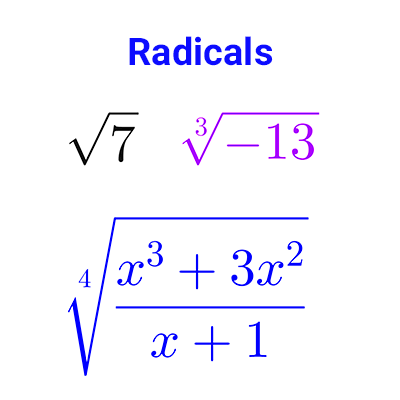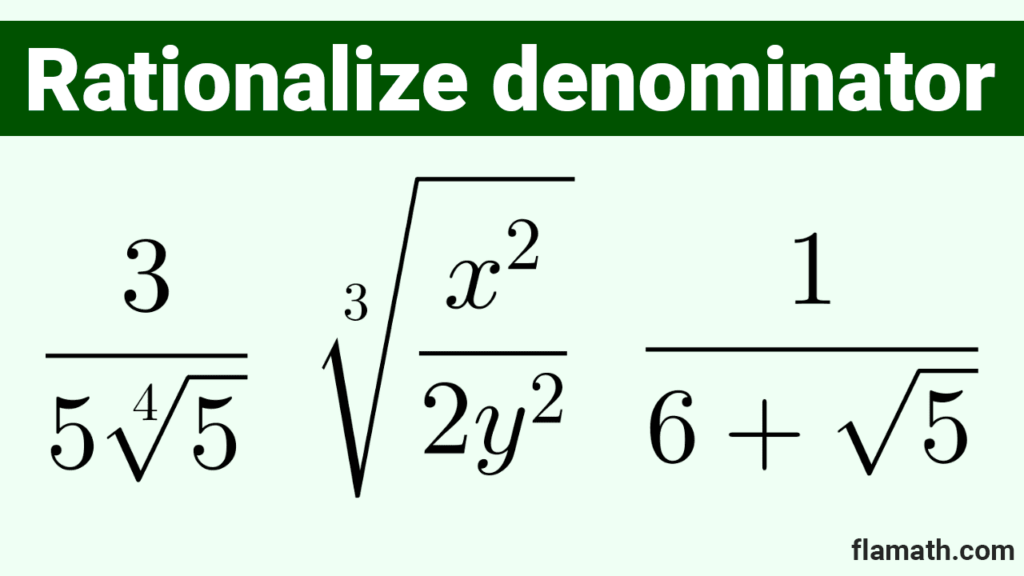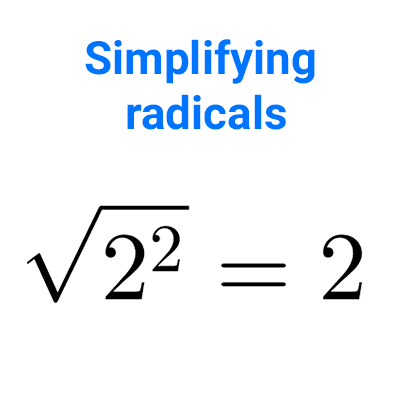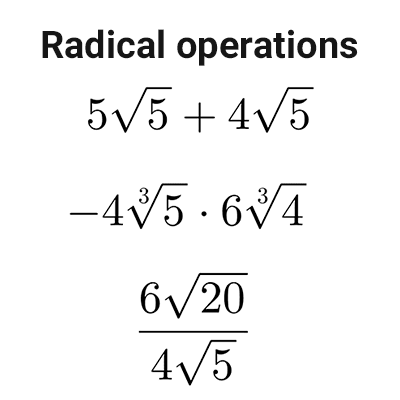
How to rationalize the denominator or numerator of an expression
This article is a guide with examples and solved exercises on how to rationalize numerators and denominators whether there are square roots, cubic roots or roots of any index; we will also see how to do it with a binomial.
Table of Contents
What is rationalizing
When square roots appear in a quotient, it is customary to rewrite it in a way that the denominator does not contain radicals, making it a rational number. This process is known as rationalizing the denominator.
To achieve this, we multiply the numerator and denominator by a factor that allows simplifying the radical's index with the radicand's exponent. This is known as the rationalizing factor. Knowing which factor is appropriate is something we will see through the different cases that can arise, both with monomials and binomials.
Sometimes it is necessary to rationalize the numerator of a quotient, which means obtaining an equivalent expression that does not have radicals in the numerator. The process is similar to that used for rationalizing the denominator, so we will go through them together.
Case 1: Rationalizing a square root
To rationalize an expression with a square root in the denominator, multiply the numerator and denominator by that same square root.
*\dfrac{a}{b\sqrt{x}}=\dfrac{a}{b\sqrt{x}}\cdot \dfrac{\sqrt{x}}{\sqrt{x}}=\dfrac{a\sqrt{x}}{(\sqrt{x})^2}=\dfrac{a\sqrt{x}}{x}*
In the following table, special cases of roots are shown along with their rationalizing factor.
| Denominator radical | Multiply and divide by | New denominator |
|---|---|---|
| *\sqrt{2}* | *\sqrt{2}* | *(\sqrt{2})^2=2* |
| *-\sqrt{5}* | *-\sqrt{5}* | *(-\sqrt{5})^2=5* |
| *\sqrt{y}* | *\sqrt{y}* | *(\sqrt{y})^2=|y|* |
Examples:
*\dfrac{1}{\sqrt{2}}=\dfrac{1}{\sqrt{2}}\cdot \dfrac{\sqrt{2}}{\sqrt{2}}=\dfrac{\sqrt{2}}{(\sqrt{2})^2}=\dfrac{\sqrt{2}}{2}*
*\dfrac{5}{4\sqrt{2}}=\dfrac{5}{4\sqrt{2}}\cdot \dfrac{\sqrt{2}}{\sqrt{2}}=\dfrac{5\sqrt{2}}{4(\sqrt{2})^2}=\dfrac{5\sqrt{2}}{4\cdot 2}=\dfrac{5\sqrt{2}}{8}*
*\sqrt{\dfrac{3}{7}}=\dfrac{\sqrt{3}}{\sqrt{7}}\cdot \dfrac{\sqrt{7}}{\sqrt{7}}=\dfrac{\sqrt{3\cdot 7}}{(\sqrt{7})^2}=\dfrac{\sqrt{21}}{7}*
If there are variables, the procedure is the same, assuming all radicals exist.
*\sqrt{\dfrac{3}{2x}}* with *x>0*
*\sqrt{\dfrac{3}{2x}}=\dfrac{\sqrt{3}}{\sqrt{2x}}\cdot \dfrac{\sqrt{2x}}{\sqrt{2x}}=\dfrac{\sqrt{3\cdot 2x}}{(\sqrt{2x})^2}=\dfrac{\sqrt{6x}}{2x}*
In the case of having to rationalize a numerator, we follow the same procedure but multiply and divide by the numerator's radical.
*\dfrac{\sqrt{8}}{\sqrt{3}}=\dfrac{\sqrt{8}}{\sqrt{3}}\cdot \dfrac{\sqrt{8}}{\sqrt{8}}=\dfrac{(\sqrt{8})^2}{\sqrt{3\cdot 8}}=\dfrac{8}{\sqrt{24}}*
Case 2: Rationalizing a root of any index
If the denominator of a quotient contains a factor of the form *\sqrt[n]{x^k},* with k and *x>0,* then multiplying the numerator and denominator by *\sqrt[n]{x^{n-k}}* will remove the radical from the denominator:
*\dfrac{a}{b\sqrt[n]{x^k}}=\dfrac{a}{b\sqrt[n]{x^k}}\cdot \dfrac{\sqrt[n]{x^{n-k}}}{\sqrt[n]{x^{n-k}}}=\dfrac{a\sqrt[n]{x^{n-k}}}{b\sqrt[n]{x^{k+n-k}}}=\dfrac{a\sqrt[n]{x^{n-k}}}{b\sqrt[n]{x^n}}=\dfrac{a\sqrt[n]{x^{n-k}}}{bx}*
Some examples of suitable factors are given in the following table.
| Denominator Radical | Multiply and divide by | New denominator |
|---|---|---|
| *\sqrt[3]{a}* | *\sqrt[3]{a^2}* | *\sqrt[3]{a^3}=a* |
| *\sqrt[5]{a^3}* | *\sqrt[5]{a^2}* | *\sqrt[5]{a^5}=a* |
| *\sqrt[8]{a^3}* | *\sqrt[8]{a^5}* | *\sqrt[8]{a^8}=|a|* |
Note that the exponent of the radicand of the rationalizing factor is equal to the difference between the index and the exponent of the original radical. For example, in the last row, the difference between the index and the exponent is *8-3=5,* so the exponent of the factor will be *5.*
Examples:
*\dfrac{1}{\sqrt[3]{7}}=\dfrac{1}{\sqrt[3]{7}}\cdot \dfrac{\sqrt[3]{7^2}}{\sqrt[3]{7^2}}=\dfrac{\sqrt[3]{7^2}}{\sqrt[3]{7^3}}=\dfrac{\sqrt[3]{49}}{7}*
*\dfrac{3}{5\sqrt[4]{5}}=\dfrac{3}{5\sqrt[4]{5}}\cdot \dfrac{\sqrt[4]{5^3}}{\sqrt[4]{5^3}}=\dfrac{3\sqrt[4]{5^3}}{5\sqrt[4]{5^4}}=\dfrac{3\sqrt[4]{5^3}}{5\cdot 5}=\dfrac{3\sqrt[4]{5^3}}{25}*
*\sqrt[3]{\dfrac{x^2}{2y^2}}, y≠0*
*\dfrac{\sqrt[3]{x^2}}{\sqrt[3]{2y^2}}=\dfrac{\sqrt[3]{x^2}}{\sqrt[3]{2y^2}}\cdot \dfrac{\sqrt[3]{(2y^2)^2}}{\sqrt[3]{(2y^2)^2}}=\dfrac{\sqrt[3]{x^2\cdot (2y^2)^2}}{\sqrt[3]{(2y^2)^3}}=\dfrac{\sqrt[3]{x^2\cdot 4y^4}}{2y^2}=\dfrac{\sqrt[3]{4x^2y^4}}{2y^2}*
The expression can be further simplified, and a *y* can be extracted from the numerator:
*\dfrac{\sqrt[3]{4x^2y^4}}{2y^2}=\dfrac{y\sqrt[3]{4x^2y}}{2y^2}=\dfrac{\sqrt[3]{4x^2y}}{2y}*
Case 3: Rationalizing a binomial
Given a binomial *a+b,* its conjugate is *a-b.* The concept of conjugate factor is used to rationalize the denominator of a fraction when the denominator is a binomial that contains a square root.
To rationalize an expression with a denominator where a binomial with square roots appears, multiply and divide by the conjugate of the denominator.
*\dfrac{a}{\sqrt{x}+\sqrt{y}}=\dfrac{a}{\sqrt{x}+\sqrt{y}}\cdot \dfrac{\sqrt{x}-\sqrt{y}}{\sqrt{x}-\sqrt{y}}=\dfrac{a(\sqrt{x}-\sqrt{y})}{\sqrt{x^2}-\sqrt{y^2}}=\dfrac{a(\sqrt{x}-\sqrt{y})}{x-y}*
Apply the difference of squares property: *(a+b)(a-b)=a^2-b^2*
In the following table, some examples of conjugates are shown.
| Denominator | Multiply and divide by | New denominator |
|---|---|---|
| *\sqrt{3}+\sqrt{7}* | *\sqrt{3}-\sqrt{7}* | *3-7=-4* |
| *5-\sqrt{11}* | *5+\sqrt{11}* | *5^2-11=14* |
| *-\sqrt{2}+\sqrt{15}* | *-\sqrt{2}-\sqrt{15}* | *2-15=-13* |
| *-\sqrt{20}-6* | *-\sqrt{20}+6* | *20-6^2=-16* |
It is important not to change all signs, only the sign of the second term.
Example 1:
*\dfrac{1}{6+\sqrt{5}}=\dfrac{1}{6+\sqrt{5}}\cdot \dfrac{6-\sqrt{5}}{6-\sqrt{5}}*
*=\dfrac{6-\sqrt{5}}{6^2-(\sqrt{5})^2}*
*=\dfrac{6-\sqrt{5}}{36-5}*
*=\dfrac{6-\sqrt{5}}{31}*
Example 2:
*\dfrac{\sqrt{2}}{\sqrt{3}-\sqrt{2}}=\dfrac{\sqrt{2}}{\sqrt{3}-\sqrt{2}}\cdot \dfrac{\sqrt{3}+\sqrt{2}}{\sqrt{3}+\sqrt{2}}*
*=\dfrac{\sqrt{2}(\sqrt{3}+\sqrt{2})}{(\sqrt{3})^2-(\sqrt{2})^2}*
*=\dfrac{\sqrt{2}\sqrt{3}+\sqrt{2}\sqrt{2}}{3-2}*
*=\dfrac{\sqrt{6}+2}{1}*
*=\sqrt{6}+2*
Example 3:
*\dfrac{6\sqrt{3}}{-\sqrt{x}+\sqrt{7}}=\dfrac{6\sqrt{3}}{-\sqrt{x}+\sqrt{7}}\cdot \dfrac{-\sqrt{x}-\sqrt{7}}{-\sqrt{x}-\sqrt{7}}*
*=\dfrac{6\sqrt{3}(-\sqrt{x}-\sqrt{7})}{(-\sqrt{x})^2-(\sqrt{7})^2}*
*=\dfrac{-6\sqrt{3}\sqrt{x}-6\sqrt{3}\sqrt{7}}{|x|-7}*
*=\dfrac{-6\sqrt{3x}-6\sqrt{21}}{|x|-7}*
FAQs
What does it mean to rationalize a denominator?
Rationalizing a denominator refers to the process of modifying the algebraic expression of a quotient so that it does not contain roots in the denominator. This is done to simplify the expression and facilitate further calculations.
How to rationalize a denominator with square root?
To rationalize a denominator with square root, both the numerator and denominator of the fraction are multiplied by the same square root.
How to rationalize a denominator with cube root?
To rationalize a denominator with a cube root, multiply both the numerator and denominator of the fraction by the same cube root squared.
How to rationalize a denominator with a binomial?
To rationalize a denominator that is a binomial where there are square roots, multiply the numerator and denominator of the fraction by the conjugate of the denominator, which results from changing the sign of the second term.



Other articles that may interest you